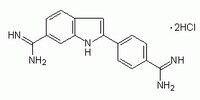268298 Sigma-AldrichDAPI, Dihydrochloride - CAS 28718-90-3 - Calbiochem
Cell-permeable DNA-binding dye.
More>> Cell-permeable DNA-binding dye. Less<<Sinônimos: 4ʹ,6-Diamidino-2-phenylindole, 2HCl
Produtos recomendados
Panorama geral
| Replacement Information |
|---|
Tabela com principais espec.
| CAS # | Empirical Formula |
|---|---|
| 28718-90-3 | C₁₆H₁₅N₅ · 2HCl |
Preço e Disponibilidade
| Número de catálogo | Disponibilidade | Embalagem | Qtde/Emb. | Preço | Quantidade | |
|---|---|---|---|---|---|---|
| 268298-10MG |
|
Ampola plástica | 10 mg |
|
— |
| Description | |
|---|---|
| Overview | Cell-permeable DNA-binding dye. Binds preferentially to DNA rich in adenine and thymine. Used in flow cytometry for measuring nuclear DNA content or for sorting isolated chromosomes. Useful for microscopic detection of nuclei and nuclear DNA in normal and apoptotic cells. Can also be used to detect mycoplasma. A reversible inhibitor of S-adenosyl-L-methionine decarboxylase and diamine oxidase. Also available as a 5 mg/ml mM solution in H2O (Cat. No. 508741). |
| Catalogue Number | 268298 |
| Brand Family | Calbiochem® |
| Synonyms | 4ʹ,6-Diamidino-2-phenylindole, 2HCl |
| Product Information | |
|---|---|
| CAS number | 28718-90-3 |
| ATP Competitive | N |
| Form | Yellow solid |
| Hill Formula | C₁₆H₁₅N₅ · 2HCl |
| Chemical formula | C₁₆H₁₅N₅ · 2HCl |
| Hygroscopic | Hygroscopic |
| Reversible | Y |
| Structure formula Image | |
| Quality Level | MQ100 |
| Applications |
|---|
| Biological Information | |
|---|---|
| Primary Target | Binds preferentially to DNA rich in adenine and thymine |
| Purity | ≥90% by HPLC |
| Physicochemical Information | |
|---|---|
| Cell permeable | N |
| Emission max. | |
| Excitation max. | |
| Dimensions |
|---|
| Materials Information |
|---|
| Toxicological Information |
|---|
| Safety Information according to GHS | |
|---|---|
| RTECS | NL5995050 |
| Safety Information |
|---|
| Product Usage Statements |
|---|
| Packaging Information |
|---|
| Transport Information |
|---|
| Supplemental Information |
|---|
| Specifications |
|---|
| Global Trade Item Number | |
|---|---|
| Número de catálogo | GTIN |
| 268298-10MG | 04055977197785 |
Documentation
DAPI, Dihydrochloride - CAS 28718-90-3 - Calbiochem MSDS
| Título |
|---|
DAPI, Dihydrochloride - CAS 28718-90-3 - Calbiochem Certificados de análise
| Título | Número do lote |
|---|---|
| 268298 |
Referências
| Visão geral de referência |
|---|
| Mathieu, C., et al. 1995. Exp. Cell Res. 216, 13. Cubria, C., et al. 1994. Comp. Biochem. Physiol. C. 105, 251. Hotz, M.A., et al. 1994. Cytometry 15, 237. Lee, L.S., and Garnett, H.M. 1993. J. Biochem. Biophys. Methods 26, 249. Miller, T., et al. 1993. Biotechniques 15, 1042. Gray, J.W., et al. 1982. Science 238, 323. Hessling, J.J., et al. 1980. J. Immunol. Methods 38, 315. Russels, W.C., et al. 1975. Nature 253, 461. |
Brochura
| Título |
|---|
| Caspases and other Apoptosis Related Tools Brochure |
Informações técnicas
| Título |
|---|
| LentiBrite™ Lentiviral Biosensors for Fluorescent Cellular Imaging: Analysis of Autophagosome Formation |







